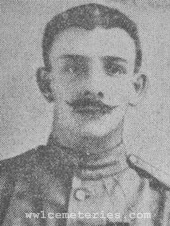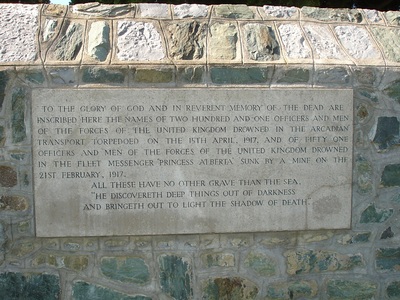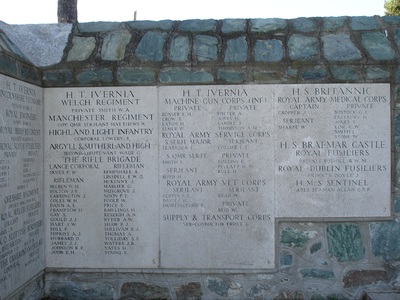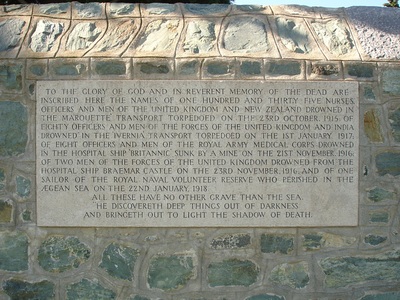MIKRA MEMORIAL
Kalamaria
Greece
Location Information
Mikra Memorial is inside Mikra British Cemetery and is situated in the Municipality of Kalamaria in the city of Thessaloniki just off Konstantinou Karamanlis Street between the army camp of Ntalipi (pronounced Dalipi) and the Kalamaria Greek Communal Cemetery.
From both the town centre and airport of Thessaloniki it is approximately a 20 minute drive
and can be accessed by first driving along Leoforos Ethnikis Antistaseos highway then entering Makedonias Street and turning right at the top of this road at the traffic lights. From there you enter Konstantinou Karamanlis and the cemetery is approx 300 metres further on your right and a CWGC sign is clearly visible.
Visiting Information
The Cemetery is permanently open and may be visited at any time.
Historical Information
At the invitation of the Greek Prime Minister, M.Venizelos, Salonika (now Thessalonika) was occupied by three French Divisions and the 10th (Irish) Division from Gallipoli in October 1915. Other French and Commonwealth forces landed during the year and in the summer of 1916, they were joined by Russian and Italian troops. In August 1916, a Greek revolution broke out at Salonika, with the result that the Greek national army came into the war on the Allied side.
The town was the base of the British Salonika Force and it contained, from time to time, eighteen general and stationary hospitals. Three of these hospitals were Canadian, although there were no other Canadian units in the force.
The earliest Commonwealth burials took place in the local Protestant and Roman Catholic cemeteries, and the Anglo-French (now Lembet Road) Military Cemetery was used from November 1915 to October 1918. The British cemetery at Mikra was opened in April 1917, remaining in use until 1920. The cemetery was greatly enlarged after the Armistice when graves were brought in from a number of burial grounds in the area.
MIKRA BRITISH CEMETERY now contains 1,966 Commonwealth burials of the First World War.
Identified Casualties: United Kingdom 1,804, Bulgaria 95, Russia 33, Greece 8, Australia 1, New Zealand 1. Total 1,942.
Unidentified Casualties: 24. Total 24.
Within the cemetery will be found the MIKRA MEMORIAL, commemorating almost 500 nurses, officers and men of the Commonwealth forces who died when troop transports and hospital ships were lost in the Mediterranean, and who have no grave but the sea. They are commemorated here because others who went down in the same vessels were washed ashore and identified, and are now buried at Thessalonika.
The ships were:
HT "Marquette", torpedoed and sunk by 'U35' on 23 October 1915, 57.5 kilometres south from Salonika Bay, carrying the 29th Division Ammunition Column and the New Zealand Stationary Hospital.
HT "Ivernia", torpedoed and sunk on 1 January 1917, 93 kilometres from Cape Matapan, carrying reinforcements for Egypt.
HT "Arcadian" was torpedoed and sunk on 15 April 1917, 41.5 kilometres north east from the island of Milo (Melos), carrying reinforcements for Egypt.
Hospital Ship "Britannic", of the White Star Line, sunk by mine on 21 November 1916 in the Zea Channel between Greece and the Cyclades, on her way from Naples to Mudos.
Fleet Messenger "Princess Alberta", sunk by mine between Stavros and Mudros on 21 February 1917.
Commemorated: United Kingdom 448, New Zealand 31, India 1. Total 480.
Memorial Pictures © Demosthenes Lamprinakis
Mikra Memorial is inside Mikra British Cemetery and is situated in the Municipality of Kalamaria in the city of Thessaloniki just off Konstantinou Karamanlis Street between the army camp of Ntalipi (pronounced Dalipi) and the Kalamaria Greek Communal Cemetery.
From both the town centre and airport of Thessaloniki it is approximately a 20 minute drive
and can be accessed by first driving along Leoforos Ethnikis Antistaseos highway then entering Makedonias Street and turning right at the top of this road at the traffic lights. From there you enter Konstantinou Karamanlis and the cemetery is approx 300 metres further on your right and a CWGC sign is clearly visible.
Visiting Information
The Cemetery is permanently open and may be visited at any time.
Historical Information
At the invitation of the Greek Prime Minister, M.Venizelos, Salonika (now Thessalonika) was occupied by three French Divisions and the 10th (Irish) Division from Gallipoli in October 1915. Other French and Commonwealth forces landed during the year and in the summer of 1916, they were joined by Russian and Italian troops. In August 1916, a Greek revolution broke out at Salonika, with the result that the Greek national army came into the war on the Allied side.
The town was the base of the British Salonika Force and it contained, from time to time, eighteen general and stationary hospitals. Three of these hospitals were Canadian, although there were no other Canadian units in the force.
The earliest Commonwealth burials took place in the local Protestant and Roman Catholic cemeteries, and the Anglo-French (now Lembet Road) Military Cemetery was used from November 1915 to October 1918. The British cemetery at Mikra was opened in April 1917, remaining in use until 1920. The cemetery was greatly enlarged after the Armistice when graves were brought in from a number of burial grounds in the area.
MIKRA BRITISH CEMETERY now contains 1,966 Commonwealth burials of the First World War.
Identified Casualties: United Kingdom 1,804, Bulgaria 95, Russia 33, Greece 8, Australia 1, New Zealand 1. Total 1,942.
Unidentified Casualties: 24. Total 24.
Within the cemetery will be found the MIKRA MEMORIAL, commemorating almost 500 nurses, officers and men of the Commonwealth forces who died when troop transports and hospital ships were lost in the Mediterranean, and who have no grave but the sea. They are commemorated here because others who went down in the same vessels were washed ashore and identified, and are now buried at Thessalonika.
The ships were:
HT "Marquette", torpedoed and sunk by 'U35' on 23 October 1915, 57.5 kilometres south from Salonika Bay, carrying the 29th Division Ammunition Column and the New Zealand Stationary Hospital.
HT "Ivernia", torpedoed and sunk on 1 January 1917, 93 kilometres from Cape Matapan, carrying reinforcements for Egypt.
HT "Arcadian" was torpedoed and sunk on 15 April 1917, 41.5 kilometres north east from the island of Milo (Melos), carrying reinforcements for Egypt.
Hospital Ship "Britannic", of the White Star Line, sunk by mine on 21 November 1916 in the Zea Channel between Greece and the Cyclades, on her way from Naples to Mudos.
Fleet Messenger "Princess Alberta", sunk by mine between Stavros and Mudros on 21 February 1917.
Commemorated: United Kingdom 448, New Zealand 31, India 1. Total 480.
Memorial Pictures © Demosthenes Lamprinakis

7364 Private
James Bennett
2nd Shropshire Light Infantry
Died at sea 21st February 1917, aged 33.
Son of Mrs. Alice Ann Bennett, of Shaw St., Burnley; husband of Annie Lacy (formerly Bennett), of 47, New Hall St., Burnley.
James Bennett
2nd Shropshire Light Infantry
Died at sea 21st February 1917, aged 33.
Son of Mrs. Alice Ann Bennett, of Shaw St., Burnley; husband of Annie Lacy (formerly Bennett), of 47, New Hall St., Burnley.








